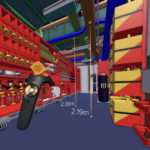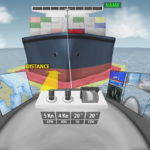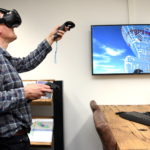From visions to applications in ship design, construction, operation and inspection: Hans Payer reports on the 18th COMPIT Conference for »Computer and IT Applications in the Maritime Industries«
The conference was held this year in Tullamore from March 25 through 27, a small town in the center of[ds_preview] Ireland. Tullamore is known worldwide for its splendid Irish Whiskey. Compit has come a long way, and like an excellent whiskey, it has ripened during its 18 years. Today it brings together some of the brightest minds of the shipping world once a year in alternating places. 43 papers were presented in eleven thematic sessions, such as »Zen and the art of computer-aided ship design«, »VR-tigo« or virtual reality, »Seeing eye to eye with AI«, Digital training and Unmanned ships on the horizon.
In the past years, exciting visions, digital possibilities and plans for the introduction of new techniques were presented. Several of the presentations in this year’s conference, by contrast, covered developments and introductions of these new techniques in concrete cases.
Robert Spencer from Sterling Labs in Perth, Australia, described the future of ship design as a collaboration between partners in Virtual Reality (VR). Since many of the expressions and definitions in the digital world are not standardised, and the developments proceed very fast, it is generally important to well define the topic to be discussed. Spencer used the term Virtual Reality to describe the experience of using a head-mounted computer display (HMD) with a highly accurate 6-degree-of-freedom positional tracking system together with a computer software which imperceptibly updates the user movement. This is done with such fidelity that the user has the illusion he or she is immersed in the virtual reality environment displayed in the HMD.
The software uses this capability to present a virtual reality environment with both, a place and plausibility illusion. It causes the sensation of being in a real place and that the scenarios experienced are actually occurring in real time around him.
VR in shipbuilding brings the ability for all parties to deeply understand and communicate the design before it is built. This can have a profound effect on how we design and build ships and improves designs and enhances operational efficiency.
Communicating 3D
Kenneth Goh from Knud E. Hansen showed examples from working in VR and underlined the high accuracy requirements for the 6 DOF tracking system and the software to make VR work. A new user may well be turned away from these capabilities if dizziness or sea-sickness sets in due to lack of accuracy of the system.
Hans van der Tas from DEKC, Groningen, talked about communicating Ship design via VR: With the developments in computer technology in the past decade it has become possible to use 3D information in the ship design process. The 3D model of the ship becomes the basis for all information as well as communication.
Communicating the ship design between the diverse parties involved, from owner, designer, building yard, equipment suppliers, class etc. plays an important role in the design process. Hans van der Tas described the new way of communicating the ship design by coupling the 3D engineering model to UNITY, a real time 3D video game development platform. Finally his colleague, Nico de Meester from DEKC ,demonstrated how to work and communicate within this new system. The Unity platform proves to be a powerful visualisation tool facilitating communication and co-operation in ship design. Connecting the players together in the same model, the communication is easy and enjoyable: Ship design quasi becomes a video game involving many different players.
VR vs. simulation
Not all virtual or augmented reality (VR / AR) projects are as encompassing as those by Spencer, Goh, or van der Tas. Britta Schulte and two colleagues from Fraunhofer Center for Maritime Logistics and Services in Hamburg for instance described a project using AR technology for shore-side assistance to remote-controlled tugs. The analysis of requirements from mariners as well as specifications of necessary features of the tug and its assistance system form the basis for a Tug Assistance System (TAS). TAS has to ensure data transfer and communication with the tug, enable line handling, steering and propulsion control and generally facilitate situational awareness. A prototype of the Situational Awareness System, SAS, is developed using an Oculus Rift as AR device and situational data from a ship handling simulator. Further testing of the prototype in the presence of experienced mariners using the simulation-based test-bed at Fraunhofer CMI will be the next step. The aim, amongst others, is to enhance the safety and the acceptability of remote-controlled tugs.
Simulation in ship design
VR is one way to arrive at a fairly clear picture of a design quite early in the design process. Tom Goodwin from Altair, UK, argues that simulation driven design is another, particularly for naval ships. It acts to solve problems in the early stages of ship design by providing naval architects with a greater understanding of the design drivers at the concept phase. Using a structural simulation, such as a finite element model in conjunction with optimisation technology, including topology optimisation, yields a first time design simulation. He discussed the merits of the simulation driven design process and shows how it is applied to local structures on the UK’s Queen Elizabeth Class (QEC) Aircraft Carrier.
Digital training & inspection
Tracy Plowman and Volker Bertram from DNV GL, in their paper »A Hitchhiker’s Guide to the Galaxy of Maritime e-Learning«, present a valuable state of the art guide. The big advantage is the flexibility to train where and when you need it and to choose your subject individually. There is a misconception that digital means cheap. It requires cooperation between digital training experts and subject matter experts and takes longer than writing a book or an article. Generally it is not better nor worse than classroom training. The authors included sections on key technologies for digital learning, live online training, true e-learning, the role of simulations. The next decade will see digital training solutions on the rise. We will see classroom training – possibly improved by brain-friendly training techniques recently introduced – and blended learning and fully digital solutions together, as they address different training needs and have each their justification.
Several participants have been to Compit before and some reported on progress with projects described at earlier events. One such well-known speaker was Erik Stensrud from DNV GL. He described progress in using drones to inspect big tanks in tankers and bulk-carriers. Success as well as limitations were reported and advantages such as cost savings and increased personnel safety are described. The final goal is to develop autonomous inspection drones to reduce the need to enter tanks. Survey duration and cost are expected to be significantly reduced, combined with major safety improvements for surveyors. Close-up inspection and non-destructive testing in enclosed and poorly lit environments are still challenges for the design of the drone. First results on navigational functions, computer vision, hyper spectral imaging and ultrasonic thickness measurements were highlighted.
Paperless ship design? Not yet …
Enrique Gaspar from NTNU, Alesund, discussed the past, present and future of computer-aided ship design. As a young university professor and service-provider without personal attachment to any established software, this smart fellow had an idealistic view regarding open systems and open data, and an optimistic view of the future: following an integrated approach to ship synthesis and assuming a more open attitude between the players we can make use of the vast existing data on ship design. With the developments underway in CAD, s. a. AI and Expert Systems, the ship designer should adjust his application to the relevant computer methods to provide an open, compatible and softer approach to CAD.
Ludmilla Seppälä from Cadmatic, Finland, explores the complexity of a simple question: Can vessels be built without the use of traditional drawings? This probably was the most philosophical paper of COMPIT 2019. She made her predictions with deep insight and explores the evolution of the role CAD played in the past and will play in the future of production and manufacturing in digital-driven shipbuilding.
Looking into the future, a broad perspective is provided by foresight and socio-technological transitions and waves of transformation theories. Using the link between technological innovation and long cycles of economic growth and decline is common to most widely accepted frameworks within long wave researchers and futurists: great surges of development such as in the textile industry and the event of steam engines (1780-1830), steel and railways (1830-1880), progress in electrical and chemical engineering (1880-1930), automobiles and petrochemicals (1930-1970), IT (1970-2010), renewable energies and sustainability (2010-20XX) induce socio-economic transformation effects across all economic activities and provide the critical driving forces for each long cycle economic growth. Do we experience a change in paradigm now, after the financial instability around 2010?
Ludmilla argues: The leading role will belong to intelligent IT. CAD development in the past 40 years, for instance, tells us how a small innovation became the backbone of an industry. Besides being a modelling tool with interfaces to calculations and production systems it can become a cradle for all IT systems in shipbuilding and offshore projects: calculations, 3D modelling, production data, and further information management to serve as platform for Digital Twins and asset management in digital data-driven shipbuilding.
Will we soon have paperless ship design? Ludmilla concluded, the maritime world is not there yet: Instead of a vision statement, the paper provides an analysis for the future of drawing-less production in shipbuilding. The main aim is to open a discussion and provide input for thought for those involved in maritime industry.
Hans Payer


























